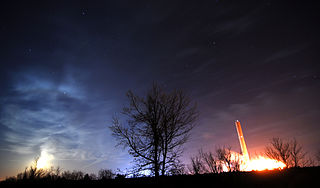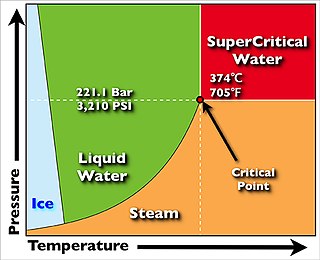
A fossil fuel power station is a thermal power station which burns a fossil fuel, such as coal or natural gas, to produce electricity. Fossil fuel power stations have machinery to convert the heat energy of combustion into mechanical energy, which then operates an electrical generator. The prime mover may be a steam turbine, a gas turbine or, in small plants, a reciprocating gas engine. All plants use the energy extracted from the expansion of a hot gas, either steam or combustion gases. Although different energy conversion methods exist, all thermal power station conversion methods have their efficiency limited by the Carnot efficiency and therefore produce waste heat.

American Electric Power (AEP), is a major investor-owned electric utility in the United States, delivering electricity to more than five million customers in 11 states.
The Keystone Generating Station is a 1.71-gigawatt, coal power plant located on roughly 1,500 acres (610 ha) in Plumcreek Township, southeastern Armstrong County, Pennsylvania near Crooked Creek, just west of Shelocta, Pennsylvania.
White Bluff Power Plant is a base load coal-fired power station in Redfield, Arkansas with a nameplate capacity of 1,800 MW and a net summer capacity of 1,638 MW. The plant is owned and operated by Entergy and has one of the tallest chimneys in the world at 305 metres (1,001 ft), built in 1980.

Clifty Creek Power Plant is a 1,300-MW coal-fired power station located in Madison, Indiana. Clifty Creek is operated by the Indiana Kentucky Electric Corporation. It is named after Clifty Creek, which enters the Ohio River nearby.

Independence Power Plant is a 1,678-megawatt coal-fired base load power plant near Newark, Arkansas. The plant has two units, rated at 850 MWe each, that came online in 1983 and 1984. The plant is owned in part by Entergy Arkansas. It has a 305-meter chimney built in 1983.
The Acid Rain Program is a market-based initiative taken by the United States Environmental Protection Agency in an effort to reduce overall atmospheric levels of sulfur dioxide and nitrogen oxides, which cause acid rain. The program is an implementation of emissions trading that primarily targets coal-burning power plants, allowing them to buy and sell emission permits according to individual needs and costs. In 2011, the trading program that existed since 1995 was supplemented by four separate trading programs under the Cross-State Air Pollution Rule (CSAPR). On August 21, 2012, the United States Court of Appeals for the District of Columbia issued its Opinion and Order in the appeal of the Cross State Air Pollution Rule (CSAPR) for two independent legal reasons. The stay on CSAPR was lifted in October 2014, allowing implementation of the law and its trading programs to begin.

Bull Run Fossil Plant, commonly known as Bull Run Steam Plant, is a 889 megawatt (MW), coal-fired electric generating station owned and operated by the Tennessee Valley Authority (TVA). The plant is the only coal fired power plant ever constructed by TVA with one unit, and is expected to close in 2023.

J. Robert Welsh Power Plant is a 1-gigawatt, coal power plant located east of Pittsburg, Texas in Titus County, Texas. It is operated by SWEPCO, a subsidiary of AEP. The plant is named after J. Robert Welsh, a former President and Board Chairman of SWEPCO.
Flint Creek Power Plant is a base load, coal fired, electrical power station located west of Gentry, Arkansas in Benton County, Arkansas.

John E. Amos Power Plant is a three-unit coal-fired power plant owned and operated by Appalachian Power, a subsidiary of American Electric Power (AEP). With a nameplate rating of 2,933 MW, it is the largest generating plant in the AEP system. It was named after John E. Amos, a prominent state senator, Democratic National Committee member from West Virginia, and member of the AEP board of directors.

General James M. Gavin Power Plant is a 2,600-megawatt supercritical coal-fired power station in the village of Cheshire, Ohio, United States. It is owned by Lightstone Generation LLC, a 50–50 joint venture of The Blackstone Group L.P. and ArcLight Capital Partners. Gavin is the largest coal-fired power facility in Ohio, and one of the largest in the US, capable of powering two million homes. In February 2017, the plant represented slightly more than 11% of the total electric generation capacity in Ohio according to the Energy Information Administration (EIA). The plant was named in honor of James Maurice "Jumpin' Jim" Gavin, the third Commanding General (CG) of the 82nd Airborne Division during World War II.

A supercritical steam generator is a type of boiler that operates at supercritical pressure, frequently used in the production of electric power.
Prairie State Energy Campus is a 1,600 megawatt base load, coal-fired, electrical power station and coal mine near Marissa, Illinois southeast of St. Louis, Missouri. Prairie State Energy Campus (PSEC) features low levels of regulated emissions compared to other coal-fired power stations, capturing sulfur from high-sulfur coal mined nearby instead of transporting low-sulfur coal from elsewhere.

The Big Sandy Power Plant is a 268 megawatt (MW), natural gas power plant owned and operated by Kentucky Power Company, a subsidiary of American Electric Power (AEP), on the shores of the Big Sandy River near Louisa, Kentucky. It was established in 1963. It was formerly a coal-fired power plant, but was converted to natural gas in 2016.

The U.S. State of Oklahoma has high potential capacity for wind power in the western half of the state. In 2017, Oklahoma's installed wind generation capacity was almost 7,500 megawatts, supplying almost a third of the state's generated electricity.

Brayton Point Power Station was a coal-fired power plant located in Somerset, Massachusetts. It was the largest coal-fired generating station in New England, and was the last coal-fired power station in Massachusetts to provide power to the regional grid. It had been owned by the power company Dominion Energy New England since 2005, after it was purchased from PG&E. The plant was owned from August 2013 to April 2015 by Energy Capital Partners, and is now owned by Dynegy. The plant ceased power generation and went offline on June 1, 2017.
The U.S. state of Arkansas is a significant producer of natural gas and a minor producer of petroleum.
Wind power in Arkansas remains nearly untapped, with just a single wind turbine in the state. Arkansas does not have a renewable portfolio standard. Studies have concluded that while Arkansas is generally considered to have low wind resources, there are significant pockets of it throughout the state.












